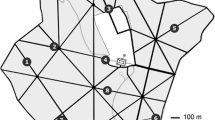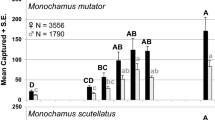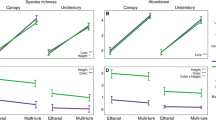Abstract
Monitoring of rare or localized saproxylic species is essential for assessing species extinction risk and to investigate the ecological integrity of forests. Morimus asper (Sulzer, 1776) (Coleoptera, Cerambycidae) is a longhorn beetle for which many aspects of its biology are still unknown and this hampers the development of a standard monitoring protocol. Here we investigated two different systems to attract M. asper in the Reserve Bosco della Fontana (Italy): freshly cut log piles (FCLPs) and pitfall traps baited with selected chemical compounds. The FCLPs were composed from logs of two tree species (Quercus robur L. or Carpinus betulus L.) utilizing wood of three diameter classes (small: 5–12 cm; medium: 13–30 cm; large: 31–60 cm). The occurrence and the detection of M. asper varied during the season and during the time of the day. M. asper was more common in the first half of the season and was more frequently detected at 20:00. Occupancy models did not show a clear influence of log diameter and tree species on species occupancy. In contrast, when analysing the abundance data, a significantly higher number of individuals was intercepted on FCLPs made from Q. robur and on those with a diameter above 13 cm. The baited pitfall traps did not catch any M. asper, even though some of the substances tested are known to attract other species belonging to the same subfamily (Lamiinae).






Similar content being viewed by others
References
Alexander KNA (2008) Tree biology and saproxylic Coleoptera: issues of definitions and conservation language. Rev Ecol (Terre Vie) 63:1–6
Allison JD, Borden JH, Seybold SJ (2004) A review of the chemical ecology of the Cerambycidae (Coleoptera). Chemoecology 14:123–150
Ambrožič Š, Kapla A, Vrezec A (2010) Monitoring scheme of saproxylic beetles in the scope of Natura 2000 in Slovenia. Book of abstracts, 6th European symposium on the conservation of saproxylic beetles, Ljubljana, p 16
Andresson K, Bergman KO, Andersson F, Hedenstrom E, Jansson N, Burman J, Winde I, Larsson MC, Milberg P (2014) High accuracy sampling of the saproxylic diversity indicators at regional scales with pheromones: the case of Elater ferrugineus (Coleoptera, Elateridae). Biol Conserv 171:156–166
Barbour JD, Millar JG, Rodstein J, Ray AM, Alston DG, Rejzek M, Dutcher JD, Hanks LM (2011) Synthetic 3,5-dimethyldodecanoic acid serves as a general attractant for multiple species of Prionus (Coleoptera: Cerambycidae). Ann Entomol Soc Am 104:588–593
Bologna MA, Rovelli V, Zapparoli M, (2016) Schede di monitoraggio delle specie animali terrestri e delle acque interne italiane. Invertebrati, pp 13–122; In: Stoch F, Genovesi P (eds) Manuali per il monitoraggio di specie e habitat di interesse comunitario (Direttiva 92/43/CEE) in Italia: specie animali. ISPRA, Serie Manuali e linee guida, 141/2016, p 364
Bordignon S, Foddai D, Racasso C, Minelo A (1992) Comparative morphology of italian long-horn beetles (Coleóptera, Cerambycidae) in relation to terrestrial locomotion and activity patterns. Lavori della Società Veneziana di Sci Nat 17:69–85
Burnham KP, Anderson DR (2002) Model selection and multimodel inference: a practical information-theoretic approach. Springer, Berlin
Buse J, Ranius T, Assmann T (2008) An endangered longhorn beetle associated with old oaks and its possible role as an ecosystem engineer. Conserv Biol 22:329–337
Campanaro A, Bardiani M, Spada L, Carnevali L, Montalto F, Antonini G, Mason F, Audisio P (2011) Linee Guida per il monitoraggio e la conservazione dell’entomofauna saproxilica, vol 6. Quaderni Conservazione Habitat, Cierre Grafica, Verona, p 8
Campanaro A, Hardersen S, Minari E, Toni I, Mason F (eds) (2014) Piano di gestione della Riserva Naturale Statale e Sito Natura 2000 “Bosco Fontana”. Aggiornamento 2014–2020, vol 8. Quaderni Conservazione Habitat, Cierre edizioni, Verona, p 265
Cardoso P (2012) Habitats Directive species lists: urgent need of revision. Insect Conserv Diver 5:169–174
Chapman JW, Birkett MA, Pickett JA, Woodcock CM, Wood PJ (2002) Chemical ecology and conservation of the stag beetle, Lucanus cervus. In: Hardie J, Tosh CR, Powell G A8-chemical communication: from hormones to semiochemicals. Abstr Comp Biochem Physiol Part 132:S63
Chiari S, Bardiani M, Zauli A, Hardersen S, Mason F, Spada L, Campanaro A (2013a) Monitoring of the saproxylic beetle Morimus asper (Sulzer, 1776) (Coleoptera: Cerambycidae) with freshly cut log piles. J Insect Conserv 17:1255–1265
Chiari S, Zauli A, Mazziotta A, Luiselli L, Audisio P, Carpaneto GM (2013b) Surveying an endangered saproxylic beetle, Osmoderma eremita, in Mediterranean woodlands: a comparison between different capture methods. J Insect Conserv 17:171–181
Chiari S, Zauli A, Audisio P, Campanaro A, Donzelli PF, Romiti F, Svensson GP, Tini M, Carpaneto GM (2014) Monitoring presence, abundance and survival probability of the stag beetle, Lucanus cervus, using visual and odour-based capture methods: implications for conservation. J Insect Conserv 18:99–109
Dajoz R (1976) Étude morphologique et biométrique des Morimus (Col. Cerambycidae) de la faune européenne. L’Entomologiste 326: 212–231
Davies ZG, Tyler C, Stewart GB, Pullin AS (2008) Are current management recommendations for saproxylic invertebrates effective? A systematic review. Biodivers Conserv 17:209–234
Dojnov B, Vujcic Z, Bozic N, Margetic A, Vujcic M, Nenadovic V, Ivanovic J (2012) Adaptations to captive breeding of the longhorn beetle Morimus funereus (Coleoptera: Cerambycidae); application on amylase study. J Insect Conserv 16:239–247
Drag L, Hauck D, Pokluda P, Zimmermann K, Cizek L (2011) Demography and dispersal ability of a threatened saproxylic beetle: a mark-recapture study of the Rosalia Longicorn (Rosalia alpina). PloS ONE 6(6):e21345
Duelli P, Wermelinger B (2005) Rosalia alpina L. Un Cerambicide raro ed emblematico. Sherwood 114:19–25
Fonseca MG, Vidal DM, Zarbin PHG (2010) Male-produced sex pheromone of the cerambycid beetle Hedypathes betulinus: chemical identification and biological activity. J Chem Ecol 36:1132–1139
Groom MJ, Meffe GK, Carroll CR (2006) Principles of conservation biology, 3rd edn. Sinauer Associates, Sunderland, Mass
Grove SJ (2002) Saproxylic insect ecology and the sustainable management of forests. Annu Rev Ecol Syst 33:1–23
Hanks LM (1999) Influence of the larval host plant on reproductive strategies of cerambycid beetles. Annu Rev Entomol 44:483–505
Harvey D, Hawes CJ, Gange AC, Finch P, Chesmore D, Farr I (2011) Development of non-invasive monitoring methods for larvae and adults of the stag beetle Lucanus cervus. Insect Conserv Diver 4:4–14
Johnson DT, Lewis BA, Bryant RJ, Liyanage R, Lay JO, Pszczolkowski MA (2009) Attractants for the Green June Beetle (Coleoptera: Scarabaeidae). J Econ Entomol 102:2224–2232
Kellner KF, Swihart RK (2014) Accounting for imperfect detection in ecology: a quantitative review. PLoS ONE 9(10):e111436
Kendall WL, Hines J, Nichols J, Campbell Grant A (2013) Relaxing the closure assumption in occupancy models: staggered arrival and departure times. Ecology 94:610–617
Larsson MC, Svensson GP (2009) Pheromone monitoring of rare and threatened insects: exploiting a pheromone-kairomone system to estimate prey and predator abundance. Conserv Biol 6:1516–1525
Larsson MC, Svensson GP (2011) Monitoring spatiotemporal variation in abundance and dispersal by a pheromone-kairomone system in the threatened saproxylic beetles Osmoderma eremita and Elater ferrugineus. J Insect Conserv 6:891–902
Larsson MC, Hedin J, Svensson GP, Tolasch T, Francke W (2003) Characteristic odor of Osmoderma eremita identified as male-released pheromone. J Chem Ecol 29:575–587
Liendo C, Morillo F, Sanchez P, Muñoz W, Guerra J, Cabrera A, Hernández JV (2005) Olfactory behavior and electroantennographic responses of the cocoa beetle, Steirastoma breve (Coleoptera: Cerambycidae). Fla Entomol 88:117–122
Lopez-Pantoja G, Dominguez L, Sanchez-Osorio I (2008) Markrecapture estimates of the survival and recapture rates of Cerambyx welensii Kuster (Coleoptera cerambycidae) in a cork oak dehesa in Huelva (Spain). Cent Eur J Biol 3:431–441
Lopez-Pantoja G, Dominguez L, Sanchez-Osorio I (2011) Analysis of Prinobius myardi Mulsant population dynamics in a Mediterranean cork oak stand. Ann Soc Entomol Fr 47:260–268
Lopez-Vaamonde C, Pino-Perez JJ, Martinez-Fernandez A, Fernandez-Abelleira J, Devesa-Regueiro S (1993) Contribucion al conocimientode los Cerambycidae Latreille, 1804 de interes forestal (I): Morimus asper (Sulz., 1776) en Galicia (Coleoptera, Polyphaga). Congreso forestal espanol 1993, Lourinzan. Ponencias y comunicaciones 3:317–322
MacKenzie DI, Nichols JD, Lachman GB, Droege S, Royle JA, Langtimm CA (2002) Estimating site occupancy rates when detection probabilities are less than one. Ecology 83:2248–2255
MacKenzie DI, Nichols JD, Royle JA, Pollock KH, Bailey LL, Hines JE (2006) Occupancy estimation and modeling: inferring patterns and dynamics of species occurrence. Academic Press, New York
Mason F, Cerretti P, Tagliapietra A, Speight MCD, Zapparoli M (2002) Invertebrati di una foresta della Pianura Padana, Bosco della Fontana, Primo contributo. Conservazione Habitat Invertebrati 1. Gianluigi Arcari Editore, Mantova, p 176
Méndez Iglesias M (2009) Los insectos saproxílicos en la Península Ibérica: qué sabemos y qué nos gustaría saber. Boletín de la Soc Entomol Aragonesa 44:505–512.
Mitchell RF, Graham EE, Wong JCH, Reagel PF, Striman BL (2011) Fuscumol and fuscumol acetate are general attractants for many species of cerambycid beetles in the subfamily Lamiinae. Entomol Exp Appl 141:71–77
Montgomery ME, Wargo PM (1983) Ethanol and other host derived volatiles as attractants to beetles that bore into hardwoods. J Chem Ecol 9:181–190
Musa N, Andersson K, Burman J, Andersson F, Hedenström E, Jansson N, Paltto H, Westerberg L, Winde I, Larsson MC, Bergman K, Milberg P (2013) Using sex pheromone and a multiscale approach to predict the distribution of a rare Saproxylic Beetle. PLoS ONE 8:e66149
Nichols JD, Bailey LL, O’Connell AF Jr, Talancy NW, Grant EHC, Gilbert AT, Annand EM, Husband TP, Hines JE (2008) Multi-scale occupancy estimation and modelling using multiple detection methods. J Appl Ecol 45:1321–1329
Nicolin A, Prunar S, Uruci C, Fora C (2013) Saproxylic NATURA 2000 beetles in the Nera Gorges-Beuşniţa National Park. Res J Agricult Sci 45:208–214
Nieto A, Alexander KNA (2010) European red list of saproxylic beetles. Publications Office of the European Union, Luxembourg
Polak S (2012) Phenology and mating behaviour of Morimus funereus (Coleoptera, Cerambycidae). In: Jurc M (ed) Saproxylic beetles in Europe: monitoring, biology and conservation. Stud For Slov 137:43–52
R Development Core Team (2015) R: a language and environment for statistical computing. R Found Stat Comput, Vienna
Ray AM, Millar JC, McElfresh S, Swift IP, Barbour JD (2009) Male produced aggregation pheromone of the cerambycid beetle Rosalia funebris. J Chem Ecol 35:96–103
Reut M, Cowell B, Pszczolkowski MA (2010) Traps baited with Isopropanol attract the American Carrion Beetle, Necrophila americana (L.) (Coleoptera: Silphidae). Coleopts Bull 64:230–234
Roling MP, Kearby WH (1975) Seasonal flight and vertical distribution of Scolytidae attracted to ethanol. Can Entomol 107:1315–1320
Romero-Samper J, Bahillo P (1993) Algunas observaciones sobre la districión y biología de Morimus asper (Sulzer, 1776) (Coleoptera: Cerambycidae) en la Península Ibérica. Boln Asoc Esp Ent 17:103–122
Rossi de Gasperis S, Passacantilli C, Redolfi De Zan L, Carpaneto GM (2016) Overwintering ability and habitat preference of Morimus asper: a two-year mark-recapture study with implications for conservation and forest management. J Insect Conserv 20:821–835
Sama G (2002) Atlas of the Cerambycidae of Europe and Mediterranean Area. 1: Northern, Western, Central and Eastern Europe. British Isles and Continental Europe from France (excl. Corsica) to Scandinavia and Urals. V. Kabourek, Zlin
Schnitter P, Eichen C, Ellwanger G, Neukirchen M, Schröder E (2006) Empfehlungen für die Erfassung und Bewertung von Arten als Basis für das Monitoring nach Artikel 11 und 17 der FFH Richtlinie in Deutschland. Berichte des Landesamtes für Umweltschutz Sachsen-Anhalt (Halle), Sonderheft 2
Schultz CB, Hammond PC (2003) Using population viability analysis to develop recovery criteria for endangered insects: case study of the Fender’s blue butterfly. Conserv Biol 17:1372–1385
Siitonen J (2001) Forest management, coarse woody debris and saproxylic organisms: fennoscandian boreal forest as an example. Ecol Bull 49:11–41
Silk PJ, Sweeney JD, Wu J, Price J, Gutowski JM, Kettela EG (2007) Evidence for a male-produced pheromone in Tetropium fuscum (F.) and Tetropium cinnamopterum (Kirby) (Coleoptera: Cerambycidae). Naturwissenschaften 94:697–701
Solano E, Mancini E, Ciucci P, Mason F, Audisio P, Antonini G (2013) The EU protected taxon Morimus funereus Mulsant, 1862 (Coleoptera: Cerambycidae) and its western Palaearctic allies: systematics and conservation outcomes. Conserv Genet 14(3):683–694
Speight MCD (1989) Saproxylic invertebrates and their conservation. Nature and environment series 46. Council of Europe, Strasbourg
Stockland JN, Siitonen J, Jonsson BG (2012) Biodiversity in dead wood. Cambridge University Press, Cambridge
Svensson GP, Larsson MC (2008) Enantiomeric specificity in a pheromone-kairomone system of two threatened saproxylic beetles, Osmoderma eremita and Elater ferrugineus. J Chem Ecol 34:189–197
Svensson GP, Larsson MC, Hedin J (2003) Air sampling of its pheromone to monitor the occurrence of Osmoderma eremita, a threatened beetle inhabiting hollow trees. J Insect Conserv 7:189–198
Svensson GP, Larsson MC, Hedin J (2004) Attraction of the larval predator Elater ferrugineus to the sex pheromone of its prey, Osmoderma eremita, and its implication for conservation biology. J Chem Ecol 30:353–363
Svensson G, Oleksa A, Gawronski R, Lassance JM, Larsson MC (2009) Enantiomeric conservation of the male-produced sex pheromone facilitates monitoring of threatened European hermit beetles (Osmoderma spp). Entomol Exp Appl 133(3):276–282
Sweeney JD, Silk PJ, Gutowski JM, Wu J, Lemay MA et al (2010) Effect of chirality, release rate, and host volatiles on response of Tetropium fuscum (F.), Tetropium cinnamopterum (Kirby) and Tetropium castaneum (L.) to the aggregation pheromone, fuscumol. J Chem Ecol 36:1309–1321
Sweeney JD, Silk PJ, Grebennikov V (2014) Efficacy of semiochemical-baited traps for detection of longhorn beetles (Coleoptera: Cerambycidae) in the Russian Far East. Eur J Entomol 111(3):397–406
Thomas JA (2005) Monitoring change in the abundance and distribution of insects using butterflies and other indicator groups. Philos T R Soc B 360:339–357
Thomas JA, Telfer MG, Roy DB, Preston CD, Greenwood JJD, Asher J, Fox R, Clarke RT, Lawton JH (2004) Comparative losses of British butterflies, birds, and plants and the global extinction crisis. Science 303:1879–1881
Thomas SL, Wagner RG, Halteman WA (2009) Influence of harvest gaps and coarse woody material on click beetles (Coleoptera: Elateridae) in Maine’s Acadian forest. Biodivers Conserv 18:2405–2419
Tolasch T, Fragstein M, Steidle JLM (2007) Sex pheromone of Elater ferrugineus L. (Coleoptera: Elateridae). J Chem Ecol 33:2156–2166
Trizzino M, Audisio P, Bisi F, Bottacci A, Campanaro A, Carpaneto GM, Chiari S, Hardersen S, Mason F, Nardi G, Preatoni DG, Vigna TA, Zauli A, Zilli A, Cerretti P (2013) Gli artropodi italiani in Direttiva Habitat: biologia, ecologia, riconoscimento e monitoraggio. Quaderni Conservazione Habitat, 7. CFS-CNBFVR, Centro Nazionale Biodiversità Forestale. Cierre Grafica, Sommacampagna, Verona, p 256
Vrezec A, Pirnat S, Kapla A, Denac D (2008) Zasnova spremljanja stanja populacij izbranih ciljnih vrst hroscev vkljucno z dopolnitvijo predloga obmocij za vkljucitev v omrezje NATURA 2000 (koncno porocilo). Morinus funereus ,Rosalia alpina ,Cerambyx cerdo ,Osmoderma eremita, Limoniscus violaceus ,Graphoderus bilineatus. Nacionalni institut za biologijo, Ljubljan
Vrezec A, Ambrožič Š, Kapla A (2010) Biology and ecology offl ightless cerambycid Morimus funereus (Muslant, 1862) as a background for monitoring application: laboratory and large scalefi eld study. Book of abstracts, 6th European symposium on the conservation of saproxylic beetles, Ljubljana
Vrezec A, Ambrožič Š, Kapla A (2012) An overview of sampling method tests for monitoring schemes of saproxylic beetles in the scope of Natura 2000 in Slovenia. In: Jurc M (ed) Saproxylic beetles in Europe: monitoring, biology and conservation. Studia Forestalia Slovenica 137:73–90
Welsh AH, Lindenmayer DB, Donnelly CF (2013) Fitting and interpreting occupancy models. PLoS ONE 8(1):e52015
Zauli A, Chiari S, Hedenstrom E, Svensson GP, Carpaneto GM (2014) Using odour traps for population monitoring and dispersal analysis of the threatened saproxylic beetles Osmoderma eremita and Elater ferrugineus in central Italy. J Insect Conserv 18:801–813
Acknowledgements
We are grateful to colleagues and friends who helped during the surveys: D. Avanzi, D. Badano, D. Birtele, E. Bussola, A. Campanaro, S. Corezzola, P. Cornacchia, R. Fezzardi, E. Minari, R. Rollins, L. Spada, I. Toni, V. Aguiar Alves, L. Zapponi. We are also indebted to M. Ascari and O. Conti who helped building the log piles. Special thanks are due to our project manager, Franco Mason. The present work was developed within the EU project LIFE11 NAT/IT/000252, with the contribution of the LIFE financial instrument of the European Union.
Author information
Authors and Affiliations
Corresponding author
Rights and permissions
About this article
Cite this article
Hardersen, S., Cuccurullo, A., Bardiani, M. et al. Monitoring the saproxylic longhorn beetle Morimus asper: investigating season, time of the day, dead wood characteristics and odour traps. J Insect Conserv 21, 231–242 (2017). https://doi.org/10.1007/s10841-017-9970-6
Received:
Accepted:
Published:
Issue Date:
DOI: https://doi.org/10.1007/s10841-017-9970-6




